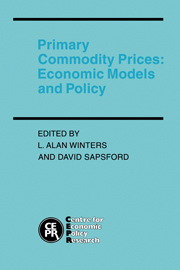Book contents
- Frontmatter
- Contents
- List of figures
- List of tables
- Preface
- List of conference participants
- 1 Primary commodity prices: an introduction to the major policy and modelling challenges
- I ECONOMETRIC ANALYSES
- 2 Estimation of dynamic disequilibrium models with rational expectations: the case of commodity markets
- 3 Modelling expectations formation in primary commodity markets
- 4 The prices of perennial crops: the role of rational expectations and commodity stocks
- II SECTORAL STUDIES: FOODS, MATERIALS AND ENERGY
- III STABILIZATION SCHEMES
- Index
4 - The prices of perennial crops: the role of rational expectations and commodity stocks
from I - ECONOMETRIC ANALYSES
Published online by Cambridge University Press: 05 March 2012
- Frontmatter
- Contents
- List of figures
- List of tables
- Preface
- List of conference participants
- 1 Primary commodity prices: an introduction to the major policy and modelling challenges
- I ECONOMETRIC ANALYSES
- 2 Estimation of dynamic disequilibrium models with rational expectations: the case of commodity markets
- 3 Modelling expectations formation in primary commodity markets
- 4 The prices of perennial crops: the role of rational expectations and commodity stocks
- II SECTORAL STUDIES: FOODS, MATERIALS AND ENERGY
- III STABILIZATION SCHEMES
- Index
Summary
Introduction
The general question of price determination is complex since it involves issues concerning the structure of markets in which a commodity is traded and whether these conditions can lead to disequilibrium. For commodities like tea and cocoa, and perhaps also other tree crops, there is a widespread presumption that price determination conforms to the basic paradigm of competitive markets, at least as a good first-order approximation. If this position is accepted, ‘price equations’ should correspond to the standard ‘law of supply and demand’ in which the change of price is a function of the gap between market demand and supply.
The elementary static market model consisting of supply and demand equations plus the equilibrium condition, will determine three endogenous variables, viz., quantity demanded, quantity supplied and the price. If an inventory accumulation identity is added to the model, so that equality of production and demand period by period is no longer required, the basic picture does not change if a new equilibrium condition is added which stipulates that the prevailing price must be such that inventories are willingly held. When inventories are included a price equation is not necessarily required to close the model.
The original research objective which instigated the present paper was intended to develop a satisfactory representation of the price formation process in the context of global econometric models for perennial crops like cocoa and tea (Akiyama and Trivedi, 1987).
- Type
- Chapter
- Information
- Primary Commodity PricesEconomic Models and Policy, pp. 72 - 102Publisher: Cambridge University PressPrint publication year: 1990



